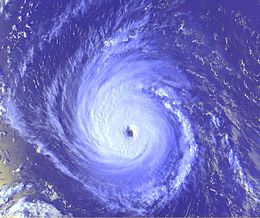Hurricane Isaac (2000)
| Category 4 major hurricane (SSHWS/NWS) | |

Hurricane Isaac on September 28, 2000
|
|
| Formed | September 21, 2000 |
|---|---|
| Dissipated | October 1, 2000 |
| Highest winds |
1-minute sustained: 140 mph (220 km/h) |
| Lowest pressure | 943 mbar (hPa); 27.85 inHg |
| Fatalities | 1 direct |
| Damage | Minimal |
| Areas affected | East Coast of the United States, Bermuda, Atlantic Canada, Europe |
| Part of the 2000 Atlantic hurricane season | |
Hurricane Isaac was a strong and large Cape Verde-type hurricane that lasted through late September and early October 2000. The thirteenth tropical cyclone, ninth named storm, and the fifth hurricane of 2000 Atlantic hurricane season, Isaac developed from a tropical wave south of Cape Verde on September 21. The depression intensified, and on the following day, it was upgraded to Tropical Storm Isaac. Due to conductive atmospheric conditions, Isaac continued to strengthen, and attained hurricane intensity on September 23. Isaac managed to become a Category 3 hurricane on September 24, before steadily weakening shortly thereafter. By September 26, the storm had deteriorated to a Category 1 hurricane. However, it again encountered favorable conditions, which caused Isaac to re-intensify.
As Isaac tracked northwestward, it re-strengthened into a major hurricane on September 28. Later that day, Isaac peaked as a moderate-Category 4 hurricane. However, Isaac began to track northward over an area of colder sea surface temperatures (SSTs), which gradually weakened the storm over the next three days. Eventually, the storm curved northeastward, and weakened to a tropical storm early on October 1. Later that day, Isaac transitioned into an extratropical cyclone. While extratropical, it brushed the British Isles, producing below gale-force winds. The storm had no interaction with land while tropical; however, one fatality occurred on Long Island when large swells generated by Isaac overturned a boat. In addition, rough seas also affected the coastlines of Bermuda and The Carolinas.
A tropical wave emerged into the Atlantic from the west coast of Africa on September 20. The wave was associated with some curvature of deep convection. Later on September 20, the initial Dvorak classification was issued, whilst convection associated with the system began to consolidate. It is estimated that the wave became Tropical Depression Thirteen at 1200 UTC on September 21, while located south of Cape Verde. Although the QuikScat satellite recorded winds of up to 60 mph (90 km/h), the National Hurricane Center set the initial intensity 35 mph (55 km/h), mostly due to a lack of deep convection and an elongated and poorly defined center. Because upper-level winds were conductive, the depression strengthened and banding features significantly improved. As a result, the depression was upgraded to Tropical Storm Isaac early on September 22. A ridge was present over parts of the eastern Atlantic Ocean which provided strong steering currents.
...
Wikipedia
